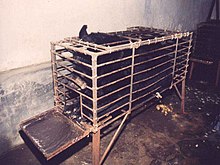Bear bile
Bear bile , the bile of bears and is used in traditional Chinese medicine used (TCM) for the treatment of eye and liver complaints.
Active ingredient
The active ingredient in bear bile is ursodeoxycholic acid (UDCA), which is synthetically produced and also used in western evidence-based medicine to dissolve small gallstones and to treat a number of liver diseases.
Manufacturing
In China and other East and Southeast Asian countries, bear bile is mainly obtained by "milking" bears. The animals are kept in tight cages on bear farms; The bile is obtained from the living animal via a plastic or steel catheter that is surgically implanted - usually without anesthesia. The bear farming was adopted in the 1980s by China from South Korea to hunt for wild bears curb. A bear can give around two kilograms of dried bear bile a year, with the bile being tapped twice a day. In total, the bear farms produce around 7,000 kilograms of bear bile annually.
Despite the trade ban in bear products in the Washington Convention on Endangered Species and the fact that the active ingredient ursodeoxycholic acid (UDCA) can be produced synthetically (Western medicine uses 200 tons of synthetic UDCA annually), the increasing demand for TCM leads to a further increase in the Number of bear farms. Chinese species protection officials confirmed to the World Animal Protection (WPA) that around 9,000 bears are now kept on 170 bear farms in China. In Vietnam, on the other hand, where the profit and sale of bear bile is prohibited, the number of collar bears and sun bears on bear farms is declining (from 4,500 in 2005 to 1,250 in 2015).
use
In traditional Chinese medicine (TCM), bear bile is used for the following and is also recommended by the state-official pharmacopoeia of China's bear bile:
- "Removes heat in the liver"
- "Provides relief from cramps and convulsive attacks"
- "Improves visual acuity"
- "Removes heat and toxic substances"
28 types of medicines patented in China contain bear bile. The dried gall bladders of hunted, wild or dead bears kept on farms are also used in traditional Chinese medicine.
In addition to the TCM medicines, bear bile is also used. a. offered in shampoos, face creams, throat drops, or toothpaste.
Prices
The demand for bear bile is high and continues to grow. According to the Animals Asia Foundation (AAF), a kilogram of bear bile costs 350 euros in China and a whole gallbladder in South Korea costs 7,500 euros.
Last but not least, the demand for bear bile is also increasing due to the TCM boom in Europe. Although the trade in bear products is strictly forbidden under the Washington Convention on Endangered Species and most Western TCM users reject bear products, research showed that up to 75 percent of TCM medicines in Western countries contain bear bile. In order to prevent the trade in bear products, a rapid test for the detection of bear proteins was developed.
Bear bile and animal welfare
The attitude of bears to the extraction of bear bile is strongly condemned by Asian and Western animal welfare organizations. The bears are generally kept in tiny cages, where, according to the AAI, their abdominal wall is repeatedly pierced with the most primitive means without any pain relief, so that the bile can drain off directly. The method is non-sterile, the catheters are contaminated after a short time and lead to chronic, painful infections of the animals in the abdomen, from which they usually die after a few years.
In connection with the 2008 Olympic Games in China, a bipartisan declaration by the European Parliament called on the Chinese government to end the practice of bile bear farming.
swell
- ↑ a b Solitary confinement for collar bears, Süddeutsche Zeitung, Wissenschaft, June 20, 2007
- ↑ China: The agony of the "Galle-Bären", Geo.de March 16, 2005
- ↑ Vietnam frees the bears from the bile farms, Welt online, April 28, 2005
- ↑ 10 years WSPA bear campaign - WSPA News, October 2002 ( Memento from November 18, 2002 in the Internet Archive )
- ↑ Brian Crudge, Trang Nguyen, Tien Trung Cao: The challenges and conservation implications of bear bile farming in Viet Nam . In: Oryx . July 2018, ISSN 0030-6053 , p. 1-8 , doi : 10.1017 / S0030605317001752 ( cambridge.org [accessed November 13, 2018]).
- ↑ Bear Rescue in China, Animals Asia Foundation (AAF) ( Memento from May 7, 2005 in the Internet Archive )
- ↑ For a handful of bile powder, derStandard, Vienna, July 13, 2007 .
- ↑ Solitary confinement for collar bears, Süddeutsche Zeitung, Wissenschaft, p. 18, June 20, 2007 .
- ^ Trading in banned bear bile, derStandard, Vienna, June 13, 2007 .
- ↑ WWF Switzerland
- ↑ European Parliament calls for an end to bear farming in China, press portal January 12, 2006 ( Memento from September 10, 2012 in the web archive archive.today )
